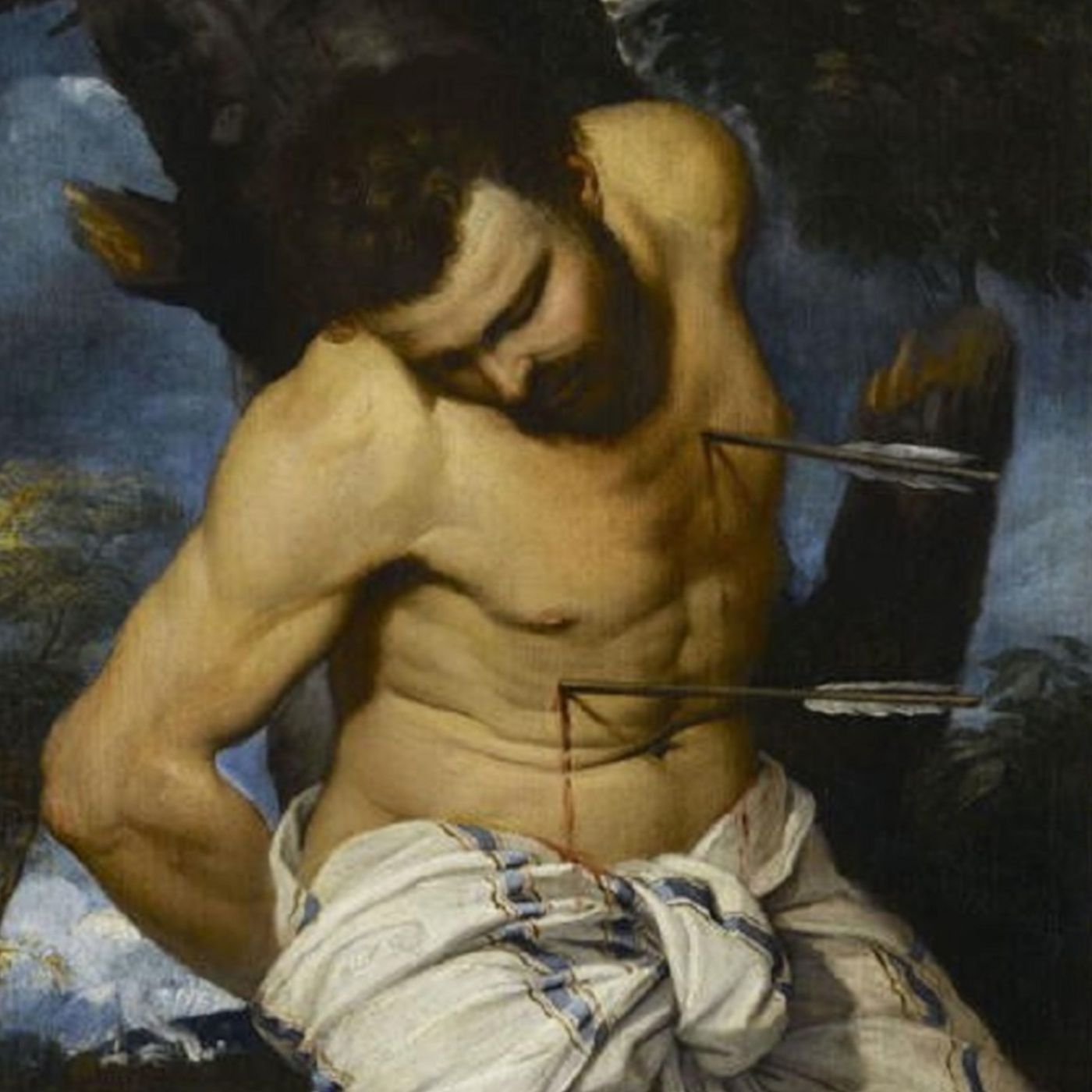
January 20: Saint Sebastian, Martyr
Late Third Century
Optional Memorial; Liturgical Color: Red
Patron Saint of athletes, soldiers, and victims of the plague
A Roman soldier makes a rugged convert and stoic martyr
The Crucifixion of Jesus Christ and the Annunciation of the Archangel Gabriel to the Virgin Mary are the most universally depicted scenes in Christian art. There is perhaps not a Catholic church the world over which does not house one or the other image, and often both. But today’s saint, Sebastian, follows close behind in terms of popularity and ubiquity. The iconic presentation of the wounded Sebastian shows his hands and arms bound to a post, his head tilted, and his almost naked body filled with arrows.
It is a powerfully evocative image. It suggests that the archers took their time. They were not rushed. They did not act in the heat of anger. Criminal psychologists have observed that killers only cover the faces of victims who they know. Otherwise, killers don’t mind watching their victims suffer and die. It seems that with Sebastian there was no hooded executioner. No anonymous hangman. The men in Sebastian’s firing squad must have gazed right into his eyes before they unleashed the tension in their bows. And when their arrows buried themselves in Sebastian’s torso, the archers must have heard his low moans. Perhaps there was an element of recrimination in all of this. Perhaps it was personal.
Sebastian was a soldier in the higher echelons of the Roman army. After his conversion to Catholicism, he went to Rome, around the year 300, likely seeking martyrdom. We can imagine that his fellow soldiers understood his conversion as betrayal or disloyalty to the empire and that this explains the unique manner of the assassination attempt. But, in the end, the attempt was a failure. Saint Sebastian, a rugged soldier, survived the arrows, was nursed back to health by Saint Irene, and later earned the martyr’s crown after being clubbed to death.
By the year 300 A.D., the Roman Emperors’ attempts to eradicate Christianity were too little too late. Nobles, senators, slaves, cobblers, carpenters, men, women, foreigners, and natives had all converted. They were men and women of every class and occupation. By 300 A.D., Christians comprised a significant portion of people at every level of society, up and down and around every Roman road. When high-placed soldiers such as Saint Sebastian were willing to die for Christ, it was a sign there was no going back to Rome’s pagan roots. All that was needed was a Christian Emperor to solidify the change. That would come soon enough in the person of Constantine. Sebastian’s heroic death was a harbinger of a world about to change. Saint Sebastian’s martyrdom was so widely known that he was honored through the construction of a Church on the Appian Way just outside of Rome. The church is still visited by pilgrims today, along with the Christian catacombs beneath it. His legacy carries on!
Saint Sebastian, we ask your intercession to fortify all those who are weak in their faith. You gave heroic witness in leaving a high station to accept a near martyrdom and then returned to suffer and die once and for all. Give us the grace to face our enemies when our weak nature wants to run the other way.
view more
Late Third Century
Optional Memorial; Liturgical Color: Red
Patron Saint of athletes, soldiers, and victims of the plague
A Roman soldier makes a rugged convert and stoic martyr
The Crucifixion of Jesus Christ and the Annunciation of the Archangel Gabriel to the Virgin Mary are the most universally depicted scenes in Christian art. There is perhaps not a Catholic church the world over which does not house one or the other image, and often both. But today’s saint, Sebastian, follows close behind in terms of popularity and ubiquity. The iconic presentation of the wounded Sebastian shows his hands and arms bound to a post, his head tilted, and his almost naked body filled with arrows.
It is a powerfully evocative image. It suggests that the archers took their time. They were not rushed. They did not act in the heat of anger. Criminal psychologists have observed that killers only cover the faces of victims who they know. Otherwise, killers don’t mind watching their victims suffer and die. It seems that with Sebastian there was no hooded executioner. No anonymous hangman. The men in Sebastian’s firing squad must have gazed right into his eyes before they unleashed the tension in their bows. And when their arrows buried themselves in Sebastian’s torso, the archers must have heard his low moans. Perhaps there was an element of recrimination in all of this. Perhaps it was personal.
Sebastian was a soldier in the higher echelons of the Roman army. After his conversion to Catholicism, he went to Rome, around the year 300, likely seeking martyrdom. We can imagine that his fellow soldiers understood his conversion as betrayal or disloyalty to the empire and that this explains the unique manner of the assassination attempt. But, in the end, the attempt was a failure. Saint Sebastian, a rugged soldier, survived the arrows, was nursed back to health by Saint Irene, and later earned the martyr’s crown after being clubbed to death.
By the year 300 A.D., the Roman Emperors’ attempts to eradicate Christianity were too little too late. Nobles, senators, slaves, cobblers, carpenters, men, women, foreigners, and natives had all converted. They were men and women of every class and occupation. By 300 A.D., Christians comprised a significant portion of people at every level of society, up and down and around every Roman road. When high-placed soldiers such as Saint Sebastian were willing to die for Christ, it was a sign there was no going back to Rome’s pagan roots. All that was needed was a Christian Emperor to solidify the change. That would come soon enough in the person of Constantine. Sebastian’s heroic death was a harbinger of a world about to change. Saint Sebastian’s martyrdom was so widely known that he was honored through the construction of a Church on the Appian Way just outside of Rome. The church is still visited by pilgrims today, along with the Christian catacombs beneath it. His legacy carries on!
Saint Sebastian, we ask your intercession to fortify all those who are weak in their faith. You gave heroic witness in leaving a high station to accept a near martyrdom and then returned to suffer and die once and for all. Give us the grace to face our enemies when our weak nature wants to run the other way.
More Episodes
March 25: Annunciation of the Lord
 2024-04-07
2024-04-07
 2024-04-07
2024-04-07
April 5: Saint Vincent Ferrer, Priest
 2024-04-04
2024-04-04
 2024-04-04
2024-04-04
April 4: Saint Isidore, Bishop and Doctor
 2024-04-02
2024-04-02
 2024-04-02
2024-04-02
April 2: Saint Francis of Paola, Hermit
 2024-04-01
2024-04-01
 2024-04-01
2024-04-01
Palm Sunday of the Passion of the Lord
 2024-03-23
2024-03-23
 2024-03-23
2024-03-23
March 17: Saint Patrick, Bishop
 2024-03-11
2024-03-11
 2024-03-11
2024-03-11
March 9: Saint Frances of Rome, Religious
 2024-03-09
2024-03-09
 2024-03-09
2024-03-09
March 8: Saint John of God, Religious
 2024-03-07
2024-03-07
 2024-03-07
2024-03-07
March 4: Saint Casimir
 2024-03-04
2024-03-04
 2024-03-04
2024-03-04
012345678910111213141516171819
Create your
podcast in
minutes
- Full-featured podcast site
- Unlimited storage and bandwidth
- Comprehensive podcast stats
- Distribute to Apple Podcasts, Spotify, and more
- Make money with your podcast
It is Free
- Privacy Policy
- Cookie Policy
- Terms of Use
- Consent Preferences
- Copyright © 2015-2024 Podbean.com






